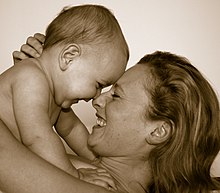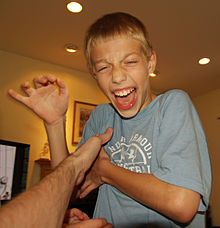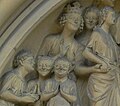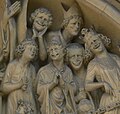Laugh
Laughter is one of the most important innate emotional expressive behaviors of humans , which not only, but above all, unfolds its effect in community with fellow human beings. Laughter is
- a person's reaction to strange or exhilarating situations
- a relief reaction after the dangers have been overcome
- a method to avert threatening social conflicts and to consolidate social relationships
- a defense mechanism against spontaneous anxiety.
The branch of science that deals with laughter is gelotology (from ancient Greek γέλως gélōs , German for “laughter” ).
Laughter or behavior similar to human laughter is also known in some animal species.
Social importance
In human togetherness, laughter is understood as an expression of sympathy and mutual understanding and thus develops a soothing, conflict-limiting effect that is conducive to living together in groups. Unproven, but not unlikely, is the assessment of some researchers that laughter is one of the fundamental forms of communication in humans, which in human history clearly precedes the development of language. This is proven by the fact that laughter is triggered and controlled in a brain region that is significantly older than the language center.
In 1963 Konrad Lorenz , in his book Das so-called Böse, originally interpreted laughter as a threatening gesture that emerged from baring teeth. It showed that someone has healthy teeth, so it demonstrates strength. But within a group there was and still has something in common: Showing one's teeth to one another means being part of a strong community and an equal partner within the group. Laughter is usually cheerful. Laughter can also occur in actually malicious situations ( sarcastic laughter). A kind of happy or sarcastic loud laugh, usually in company, is laughter .
Laughter as a reflex
Laughter is usually an involuntary act in which a stimulus transmitted to the brain by the sensory nerves is counterbalanced by being transmitted to the nerve origins of the muscles contracted when laughing. Accordingly, laughter is a so-called reflex movement and thus - like other reflex movements - has the peculiarity that it takes place most perfectly when our attention is turned away from our body. Laughter can be held back to a certain extent through self-control.
Laughter is also evoked by certain emotional impressions (such as when tickling ) and serves to a certain extent as a means of balancing out the stimulus caused by those impressions. The reflex movement of laughing can easily degenerate into a type of cramp called a laughing spasm .
Laughter as a "weapon"
In addition to strengthening the sense of community and togetherness within one's own group, laughter can also have the opposite effect on those who do not belong to the group. These can easily become those who are laughed at and at whose expense (for example, as victims of malicious, disparaging “laughing at”). From the point of view of the person being laughed at, laughter can become a humiliating, defamatory weapon in complete reversal of his cheerful nature. However, even in such situations, laughter can have an overall positive effect, as long as it is possible to defuse a conflict-prone situation by laughing without hurting the despised too much in his honor.
This effect goes back to an important anarchic basic trait of laughter, which is based on the questioning of authorities of all kinds: in laughter, every claim to respect and honor is fundamentally denied. People and institutions whose status is based on such honors are therefore fundamentally threatened by laughter and, in the interests of maintaining their own power, must strive to channel the urge to be cheerful into other channels and away from themselves. An example of such affect canalization is the ritualized reversal of the power relations, which makes up the historical core of the southern European (especially Italian) carnival celebrations and was consciously tolerated as a ritual in order to be able to return to normal everyday life afterwards. The motif of the fight against laughter by institutions that feel threatened by it also appears in the film adaptation of Umberto Eco's novel The Name of the Rose , in which the monastery librarian would rather accept the destruction of the treasures kept in his library than those in them The only surviving copy of Aristotle's theory of comedy contained therein wants to be removed from ecclesiastical control.
Medical aspects of laughter
Laughing as compulsive or convulsive laughing can also be associated with mental disorders or nervous disorders. In medicine, laughter or cheerfulness is used as a therapy support, which is popularly expressed in the phrase "Laughter is healthy". From a social-psychological point of view, excessive laughter is almost a victory of the body over the power of the otherwise dominant mind. An indication of this is the observation that in a cheerful group laughter gains a momentum of its own that is resistant to sensible considerations.
The healing process of some diseases can be promoted by laughing. Here one makes use of the increased well-being associated with laughter, which contributes to the reduction of stress and thus to an improvement in the general condition of a patient. Particularly in children's wards, good experiences have been made with regular appearances by clinical clowns .
There are special therapies that try to fight illness with laughter. By releasing hormones , the immune system is strengthened and diseases are prevented. It is assumed, for example, that when the body laughs, it activates endorphins and thereby triggers euphoric effects comparable to those experienced by a long-distance runner. Laughing stimulates the cardiovascular system, diaphragm, vocal cords, facial and abdominal muscles, which among other things leads to increased blood pressure, increased oxygen levels in the blood and a kind of internal massage of the lower abdomen. The associated physical exertion can easily lead to pain in the stressed muscle areas in people who otherwise laugh little. However, with prolonged laughter (about five to eight minutes), these symptoms give way to a feeling of relaxation and relaxation, on which, among other things, the therapeutic effect of laughter is based.
Physiognomic process
Laughing (risus) is a special breathing movement in which the exhalation is carried out in several rapid bursts with more or less strong sound. In contrast, inhalation usually takes place in a continuous, somewhat accelerated and deep breath. When laughing, however, this breathing movement is always associated with a contraction of the facial muscles , which essentially results in a widening of the mouth and lifting the corners of the mouth. If this muscle play exceeds a certain level, a grin occurs instead of laughing . If, on the other hand, it takes place to a lesser extent, it is called a smile , in which the forced exhalation can also be absent or reduced to a minimum.
anatomy
When a person laughs, many muscles are being exercised in the face and body. The eyebrows rise, the nostrils widen, the zygomatic muscle pulls the corners of the mouth upwards, the eyes narrow to slits, the breath goes faster, the air shoots through the lungs at up to 100 km / h , the vocal cords are set in motion . The sound of male laughter has at least 280 vibrations per second, that of the female even 500. The diaphragm moves rhythmically. In contrast to the tense muscles, the muscles in the leg region slacken - we tip forward with laughter. The bladder muscles also relax, hence the saying “pee in your pants while laughing”.
Lungs and heart
Laughter also strengthens the function of the lungs. Due to the rapid breathing, the lungs transport three to four times as much oxygen as normal. The pulse is racing, the blood circulation is stimulated and promoting the burning of cholesterol . After that, the previously increased heart rate decreases and the blood pressure decreases continuously. Hearty laughter also strengthens the cardiovascular system. Laughing for 20 seconds is roughly equivalent to the physical performance of three minutes of fast rowing. In addition, the risk of heart attacks is halved by frequent laughter.
immune system
After a few fits of laughter more are in the blood repellents visible than usual. Take the killer cells, for example : They attack viruses, so you get well again faster if you catch a cold. Killer cells can also destroy tumor cells.
Also immunoglobulins and various cytokines are measured. Immunoglobulins are protein bodies and are of great importance in the body's immune system. They are located in the oral cavity, get from the blood into the saliva - which also increases - and there they offer resistance to viruses and bacteria. Thus, for example, they help to prevent infections in the event of injuries. Some of the immunoglobulin effects last for hours after the laughing attack. Stress and sadness, on the other hand, lower the number of immunoglobulins. Cytokines - components of the white blood cells - can also be found more frequently after laughing and are responsible for similar defense functions.
metabolism
The number of stress hormones in the blood - adrenaline and cortisol - decreases. Happiness hormones, so-called endorphins , on the other hand, are excreted and relaxation sets in. Digestion is also stimulated. The metabolism is thus positively influenced.
Pain reduction
Even the sensation of pain is reduced. Laughing is even said to help with constipation, insomnia, and headaches. Gelotology studies have shown that pain sufferers experience relief after just a few minutes of laughter that can last for hours. This also happens through the body's own anti-inflammatory substances, which are increasingly produced.
Tears of laughter
Since tears are produced by emotional situations and psychological exceptional states, just like pain and sadness, joy also stimulates the autonomic nervous system . The lacrimal gland is activated and releases its fluid. The exact cause has not yet been adequately researched. Scientists assume, however, that people unconsciously lose tears in order to show others the state of mind .
Side effects
In addition to the many positive effects, laughter can also have negative effects on our body in special circumstances. In 1927, for example, there was even a report of fatalities due to laughter, as a patient suffered a ruptured heart muscle in an attack of laughter. More common side effects of laughing include inhalation of objects in the mouth and headache . Stress incontinence , hernias, and bruising ( hematoma ) in the straight abdominal muscle can also occur during laughter . Laughter can also cause sudden loss of consciousness ( syncope ) and sudden muscle weakness ( cataplexy ). Pneumothorax or interlobular emphysema can occur in the lungs . In people with long QT syndrome or other cardiac arrhythmias, laughter can also trigger deadly torsades de pointes .
Laughter increases health. Caution is only required in the case of disturbances with uncontrollable fits of laughter .
Philosophy and art
Aristotle had come to the realization that the ability to laugh distinguishes humans from animals.
Classical art, however, avoids laughter, if one disregards the archaic smile of the kuroi in their early days.
Between the 5th and 7th centuries there was a pejorative assessment of laughter. In contrast, the cathartic role of crying was seen as important. It seems certain that early Christian monks were in many cases forbidden to laugh because of the “master's rule”. This prohibition was justified by references from the Bible. It has to be said, however, that the sources are inconsistent, as a glance at Basil's “Longer Rule” shows.
Towards the end of the first quarter of the 12th century, scholasticism succeeded in differentiating between good and reprehensible laughter. In this context, reference can be made to the writings on laughter by Alexander von Hales , Thomas Aquinas, and Albertus Magnus . This only paved the way for an appropriate approach to laughter. During the transition period, for example, the French King Louis IX made do . with the fact that he basically didn't laugh on Fridays.
The visual arts, insofar as they want to be permanent, rejects the representation of laughter not only for the reasons of belief mentioned, but also mainly because it is only a transitory emotional reflex that is also triggered by a trigger (image, joke, comic Shape), which cannot be shown. One painter who particularly valued laughter, especially in portraiture, was Frans Hals . In the famous smile of the Mona Lisa , the welcoming moment is balanced with the defensive moment. Laughter is rarest in plastic art - probably because of its proximity to the grimace .
The dramatic art of comedy on stage or as a film aims to create laughter in the audience, for which it likes to suppress the laughter of its actors; The great stoneface Buster Keaton is a prime example of this . The clown , but also the cabaret artist, are well advised if they don't laugh themselves at their misfortunes and punch lines; if they do, they often want to expose themselves to ridicule.
Laughing politicians in a contemporary representation ( Peter Lenk )
Laughter in animals
Apes can laugh, so other than humans and chimpanzees , gorillas and orangutans .
With the help of technical devices for tickling, scientists were able to record sounds in rats and determine the laughter in these animals. Special devices are required because the giggling tones are very high and therefore imperceptible to the human ear.
Trivia
- A hearty fit of laughter can, for a short time, trigger similar sensations as taking cocaine. US scientists have shown that laughter stimulates the same brain regions. The regions of the brain that process a joke have long been known, and the euphoria that ensues is triggered in the brain's reward center , the nucleus accumbens .
Quotes
"A day without laughing is a lost day."
"The most lost of all days is the one when you haven't laughed."
"One kills not through anger, but through laughter."
The opposite of laughing is crying - so there is "time" for everything:
"Time to cry and time to laugh, time to complain and time to dance."
"And that it is he who makes you laugh and cry, and who lets you die and makes you alive?"
"Every time a person laughs, he adds a few days to his life."
"In his laugh lies the key with which we decipher the whole person."
"There is no greater power than the power of laughter."
"... only people who haven't laughed for a long time know that laughing is even better than having a woman."
"Laughter is the surest test on a person."
See also
- humor
- Therapeutic humor
- Sardonic laughter
- Smile
- smile
- Laughter club , laughter cabinet , laughter yoga
- World Laughing Day , laughter forbidden
- Death by laughter
literature
Books
- Henri Bergson : The Laughter . Translated by Julius Frankenberger, Diederichs, Jena 1914.
- Charles Darwin : The Expression of Emotions in Man and Animals . (German, critical edition, Frankfurt a. M. 2000).
- Jacques Le Goff : Laughter in the Middle Ages. Translated from the French by Jochen Grube. With an afterword by Rolf Michael Schneider . 3rd edition, Klett-Cotta, Stuttgart 2008, ISBN 978-3-608-94274-3 .
- Winfried Wilhelmy: Blissful smile and hellish laughter. Laughter in the art and culture of the Middle Ages. Catalog for the special exhibition in the Episcopal Cathedral and Diocesan Museum in Mainz, April 27 - September 16, 2015, Schnell and Steiner, Regensburg 2012, ISBN 978-3-7954-2583-8 .
- Ewald Hecker : The physiology and psychology of laughter and the comic. A contribution to experimental psychology for naturalists, philosophers and educated laypeople. Berlin 1873.
- Helmuth Plessner : laughing and crying. An examination of the limits of human behavior. In: Collected Writings, Vol. VII, 1941.
- Lenz Prütting : Homo ridens. A phenomenological study of the nature, forms and functions of laughter. Verlag Karl Alber, Freiburg / Munich. 1st edition in 3 volumes 2014, 4th edition as one-volume expanded new edition 2016. ISBN 978-3-495-48829-4
- Friedemann Richert: A short intellectual history of laughter. Scientific Book Society, Darmstadt 2009, ISBN 3-534-21620-2 .
- Hans-Georg Moeller, Günter Wohlfart (Ed.): Laughter in Eastern and Western Philosophies. Verlag Karl Alber, Freiburg / Munich 2010, ISBN 978-3-495-48385-5 .
Dissertations
- Barbara Merziger : The laughter of women in conversation about shopping and sexuality. Dissertation at the Free University of Berlin , Department of Philosophy and Humanities, 2005 DNB 977032426 ( online ).
- Susanne Schroeder: Laughing is healthy? - a popular and medical truism in the mirror of philosophy. Dissertation at the Free University of Berlin, Department of Philosophy and Humanities, 2002, DNB 964802783 ( online ).
Web links
Individual evidence
- ↑ Pit Wahl, Heiner Sasse, Ulrike Lehmkuhl: Joy - Beyond Aching and Sorrow? Vandenhoeck & Ruprecht, 2011, ISBN 978-3-525-45009-3 ( google.de [accessed April 11, 2020]).
- ↑ Reiner W. Heckl: The laughing brain: How laughter, cheerfulness and humor arise . Schattauer, 2019, ISBN 978-3-608-20428-5 ( google.de [accessed April 11, 2020]).
- ^ Wellbeing , Südwest-Fernsehen: Recording of an interview with Dr. Michael Titze
- ^ RE Furthermore, JK Aronson: Laughter and MIRTH (Methodical Investigation of Risibility, Therapeutic and Harmful): narrative synthesis. In: BMJ. 347, 2013, pp. F7274 – f7274, doi: 10.1136 / bmj.f7274 .
- ↑ Jacques Le Goff: Laughter in the Middle Ages. P. 64.
- ↑ Jacques Le Goff: Laughter in the Middle Ages. P. 59.
- ↑ Jacques Le Goff: Laughter in the Middle Ages. P. 19 ff.
- ↑ Jacques Le Goff: Laughter in the Middle Ages.
- ↑ see Heike Ostarhild: When masterpieces show their teeth. About laughter in art. Tübingen (Legat-Verlag), 2002
- ↑ M. Davila Ross, MJ Owren, E. Zimmermann: The evolution of laughter in great apes and humans . In: Communicative & Integrative Biology , Volume 3, No. 2, 2010, ISSN 1942-0889, pp. 191-194.
- ↑ Even rats can laugh. Welt-Online, April 3, 2005.









